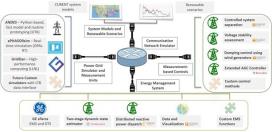Research Testbeds: Problem-Solving Tools for Long-term Power Grid Reliability
Two platforms for conducting rigorous and replicable testing of theories, tools, and equipment—a Hardware Testbed (HTB) and a Large-scale System Testbed (LTB)—that have been developed and refined over time at the University of Tennessee-Knoxville (UTK) are helping researchers evaluate technology for reliable operation of future power grids under a wide variety of conditions. These mature Generation III testbeds can accurately model and demonstrate electric grids of the future, encompassing an extensive range of relevant technologies and energy generation, transmission, distribution, and loads. Both testbeds are part of research efforts supported by the Center for Ultra-Wide-Area Resilient Electric Energy Transmission Networks (CURENT), a National Science Foundation (NSF)-funded Engineering Research Center (ERC) supported by both NSF and the U.S. Department of Energy and headquartered at UTK.
CURENT is a collaboration between academia, industry, and national energy laboratories that is led by UTK and includes partner institutions Northeastern University, Rensselaer Polytechnic Institute, and Tuskegee University. The testbeds are an integral part of CURENT’s effort to achieve a nation- or continent-wide transmission grid that is fully monitored and dynamically controlled in real-time for high efficiency, exceptional reliability, low cost, better accommodation of renewable energy sources, full use of energy storage, and the ability to accommodate fluctuations in energy demand. These testbeds will continue to drive CURENT’s research focus by identifying research and technology gaps in the electric grid to accommodate expected future grid changes. CURENT will continue to work to make them more flexible, relevant to the power industry, and able to provide a place for realistic testing of grid measurement, modeling, controls, and activation.
A high-voltage direct current (HVDC) electric power transmission system uses direct current for electric power transmission, in contrast with the more traditional alternating current (AC) transmission systems. The goal of the LTB is to develop a computer simulation-based platform with structural representation of the modern electric power system for verifying wide-area measurement-based controls. It is designed to run large-scale power grid models with thousands of power system connections and modern components, such as voltage source converters connected to solar photovoltaics or energy storage, wind generators, and multi-terminal HVDC networks. Interfaces to different simulation engines provide additional capabilities, including real-time simulation, high-performance computing, and fast model prototyping. Several scenarios, such as high penetration of wind power, generation mix, and seasonal load balances, have been created in several large-scale North American systems—Eastern Interconnection (EI), Western Electricity Coordinating Council (WECC), and Electric Reliability Council of Texas (ERCOT).
CURENT can test many different systems using the HTB to evaluate new control, monitoring, measurement, and actuation technologies, as well as drive requirements needed by future systems for these on-the-horizon grid challenges. The HTB was developed to represent an aggregated portion of future electric grids with high penetration of renewables (50% to 80%) for the EI, WECC, and ERCOT, as well as an overall North America grid with HVDC overlay through nodes representing clusters of generation, storage, and loads connected through transmission lines. Each node represents a dynamic cluster of energy generation and loads. The HTB is highly reconfigurable and runs distributively and in real-time with actual switching power converters, power flow, measurement, and control.



